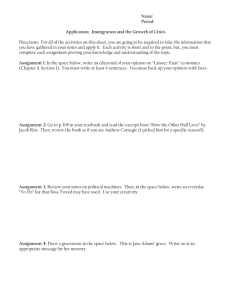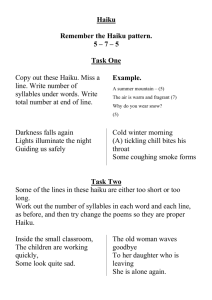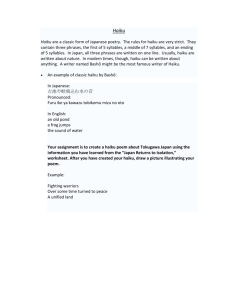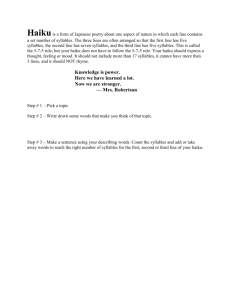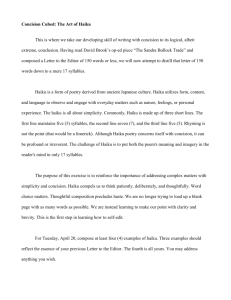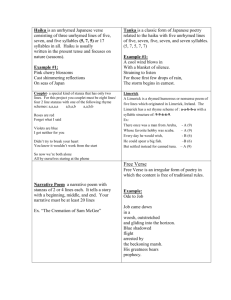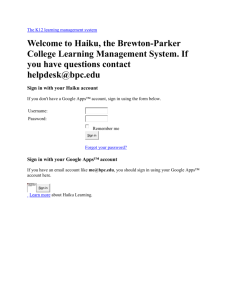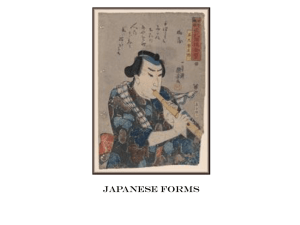- Teachers Network
advertisement
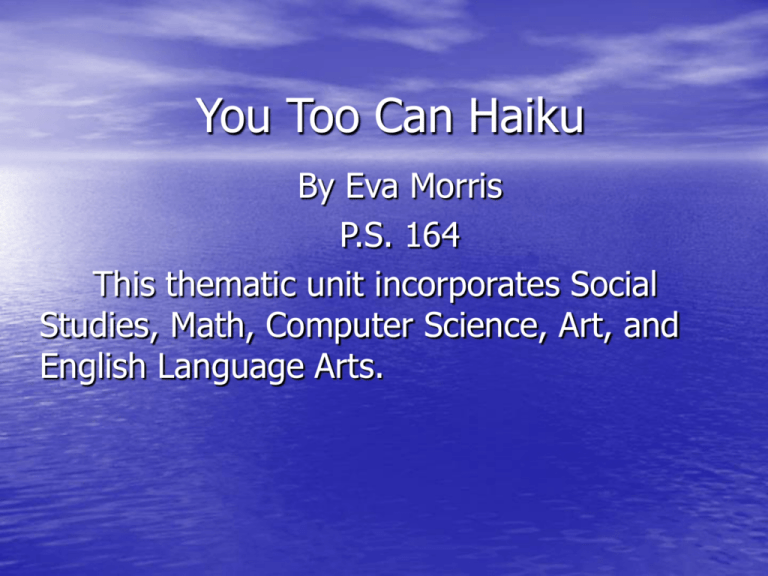
You Too Can Haiku By Eva Morris P.S. 164 This thematic unit incorporates Social Studies, Math, Computer Science, Art, and English Language Arts. • Lesson one: Length 2 lessons Subject: Social Studies, Computer Science and E.L.A. • Goal: Students will be able to explain information on the Japanese history, culture and Haiku poetry. • Students will use the Internet to explore the country of Japan in order to determine its location, resources, population and culture. • F.Q.R. worksheet is to help students focus their thinking as they read. It is similar to the K.W.L. • Teacher will display several photographs of a geisha girl, Japanese scenery and a map of the world. The students will respond to what they see and the teacher will put the responses on chart paper. • Model note taking and Visual Thinking Strategy. • The information will be placed on the chart paper • Using the overhead projector • Students work in groups viewing designated Internet web pages that display information on Japan. The students use an F.Q.R. sheet and in groups they complete the sheet documenting the facts that they found, the questions that they might have about the topic and their responses to the facts and questions that they have listed. • Students use their notes and worksheets in order to complete a graphic organizer that will be displayed as an anchor chart for future lessons. • The students write a summary of their findings for homework and Haiku poem to read • Japan is a country where many customs, ways of living, sounds, • • smells, and tastes are different than they are in our country. Hundreds of years ago, the Japanese created an art form - in the shape of a small verse. The verse is haiku (HIGH-koo). In haiku, we share the thoughts, the moods, and the feelings of the Japanese poets. Haiku grew from an early writing game in which the first three lines of a poem were written by one person. A second person wrote the closing two lines. The great Japanese writer, Basho (1644-94) grew tired of this game. He felt that the first three lines could stand alone. In that way, haiku was born. There are no rhyming words in haiku, and each 3-line verse has only 17 syllables or less! The three lines are often arranged so that the first line has five (5) syllables, the second line has seven (7) syllables, and the third line has five (5) syllables. This is called the 5-7-5 rule. Haiku does not always follow the 5-7-5 rule. But to be haiku, the verse must express a thought, feeling or mood. The verse cannot be composed of more than 17 syllables; it cannot have more than 3 lines; and it cannot rhyme. Japan Quiz • 1. What is the capital of Japan? • • • • • • ___________________________ 2. What ocean borders Japan to the east? ___________________________ 3. What body of water separates Japan from South Korea? ___________________________ 4. What is the name of the sea that separates Japan from mainland Asia (southern Russian and North Korea)? ___________________________ 5. What is the name of the sea that borders Japan to the south? ___________________________ 6. Sapporo is on the northernmost of the four major islands of Japan. What is the name of this island? ___________________________ 7. What is the name of the largest of the Japanese island? ___________________________ • Japan Japan FACTS QUESTIONS RESPONSES Lesson 2 : Subject : Poetry and Math • Goal: Explore imagery • Students will use their listening skills to hear distinct syllables and gain the ability to discriminate between them. • Understand imagery, locate descriptive language and words that pertain to nature, for use in their writing. • The class does a picture walk of the book. This establishes the motivation for listening. The students and teacher list the words of feelings, time, colors, nature and descriptive verbs found in the book as well as the descriptive language from thier homework. Teacher will read selections from the book while modeling descriptive words of imagery on to chart paper to create a word bank. The words are written under the proper category, example feelings, colors, verbs, shapes etc. The students will use kinesthetic movement, by placing their hands on their chins, to determine the syllables in each of the words that are on the chart. The students work in pairs to complete the haiku sheet and using the internet haiku sites. The teacher begins to read selections from the book description on to the chart. Discussion / share of the words and the picture in their minds. • ANSWER THE FOLLOWING QUESTIONS • What is the Haiku written about? • List the descriptive words • How many syllables are there in each line? • What picture does the poem make in your mind? • Topic Name • Adjectives/ Syllables • Verbs/ syllables • Feelings/syllables Picture in my mind/ imagery HOMEWORK HAIKU This snowy morning That black crow I hate so much .... But he's beautiful! —Basho We could hear the trees ... As we went through the forest Play with the wind —Roger, age 10 • http://homepage2.nifty.com/haiku-eg/ Lesson Three: Subject E.L.A., Poetry Math Goal: Students will compose an original Haiku poem. • Mathematical problem solving by determining the correct number of syllables per line. • Students will discover that all poetry does not rhyme. • Think Aloud as a Haiku poem is modeled on the overhead. By using the senses , and the lists • Students review the words located on the chart and personal list, from the prior lessons and compute the number of syllables in each word in order, while keeping in mind the 5,7,5 rule to compose the Haiku. • Internet resource with drop down menu. • http://www.insite.com.br/rodrigo/poet/haicreat e.html • The poem is copied onto paper to use for the next lesson. • The students begin to work on composing a Haiku. Teacher reinforces mathematical computation. • Sharing of their Haiku poems. Special Features • First line: Adjective/ Noun, • Second line: Verb/Preposition/Noun • Third line: Season or Time of year/Descriptive word. Lesson Four: Subject: Computer Science, E.L.A. and Art. • Goal: The students will type and illustrate their Haiku poem by using the “Kid Pix” computer application. • The students will use the following icons: Stamp pad, Paint brush, Typewriter and Eraser. • Revisit the book “Cool Melons Turn To Frogs” ,while doing a picture walk through the book, the teacher instructs the students to pay attention to the illustrations. • Discussing the importance of illustrations and poetry. Students engage in accountable talk regarding the pictures, the teacher listens in on the conversations and takes notes. When students are done the teacher points out some of the interesting things that her heard the students discussing. • When the students are done with their designs they are asked to answer these questions. • Why did you choose the illustrations that you used? • What was the image that you wanted the reader to see in their mind? • How did the poem make you feel? • Japan is a country where many customs, ways of living, sounds, • • smells, and tastes are different than they are in our country. Hundreds of years ago, the Japanese created an art form - in the shape of a small verse. The verse is haiku (HIGH-koo). In haiku, we share the thoughts, the moods, and the feelings of the Japanese poets. Haiku grew from an early writing game in which the first three lines of a poem were written by one person. A second person wrote the closing two lines. The great Japanese writer, Basho (1644-94) grew tired of this game. He felt that the first three lines could stand alone. In that way, haiku was born. There are no rhyming words in haiku, and each 3-line verse has only 17 syllables or less! The three lines are often arranged so that the first line has five (5) syllables, the second line has seven (7) syllables, and the third line has five (5) syllables. This is called the 5-7-5 rule. Haiku does not always follow the 5-7-5 rule. But to be haiku, the verse must express a thought, feeling or mood. The verse cannot be composed of more than 17 syllables; it cannot have more than 3 lines; and it cannot rhyme. • As you read each verse below, put yourself in the poet's place - try to share what he or she is feeling. Then share the poem with someone else. You may find that others receive a different image or feel a different mood than you do, all while reading the same words. That is one reason a haiku verse is often accompanied by an illustration. • Here is an example of haiku written by the great Japanese writer Basho. Ask yourself, what season is it? • This snowy morning That black crow I hate so much .... But he's beautiful! —Basho • The Haiku’s that were composed will be used to create a slide show presentation. • Assessment: Students will be assessed throughout the unit. They will be assessed in the following areas. • • • • 1. Participation during discussions. 2. the students piece must follow the correct Haiku format. 3. The students understanding of imagery. 4. The students utilization of their listening skills. Internet Resources: • http://www.ahapoetry.com/haiku.htm • http://www.big.or.jp/~loupe/links/ehisto/ehisinx.shtml • http://www.cln.org/themes/haiku.html • http://www.cranberrydesigns.com/poetry/haiku/history. • Htm • http://www.fthsonline.com/mgeib/socialsciences/haiku%20samples.htm • http://www.gardendigest.com/poetry/haiku4.htm • http://www.insite.com.br/rodrigo/poet/haicreate.html • http://www.japan-zone.com/culture/index.shtml Bibliography: • Black Swan/White Crow. By Lewis J. Patrick, Atheneum, 1995 • The Classic Tradition of Haiku: An Anthology. Dover Publications, Dover Third Edition, 1996. • Cool Melons - Turn to Frogs: The Life and Poems of Issa. Edited by Matthew Gollub, • illustrated by Kazuko G. Stone and Keiko Smith. Lee and Low Books, 1998. Cricket Never Does: A Collection of Haiku and Tanka. By Myra Cohn Livingston. Illustrated by Kees De Kiefte. Margaret McElderry, 1997. • Students Involved The students are third-grade, special-needs, general-education, and English-language learners. They must be familiar with the computer and the Kid Pix program. • Teacher Tips The completion of the homework assignments is essential because those poems are used to begin the lesson the following day. • Overall Value This unit introduces the students to Haiku poetry in an interactive fashion. The students learn about Japanese culture and history as they investigate the designated websites. They become better listeners and composers of poetry while understanding that all forms of poetry do not rhyme. The Kid Pix application assists in bringing their written forms of imagery to a visual format. This unit empowers students with difficulty visualizing, drawing, and writing. By using the application with the Internet, the students are eager to learn.
